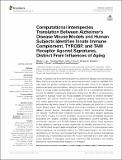| dc.contributor.author | Lee, Meelim J. | |
| dc.contributor.author | Wang, Chuangqi | |
| dc.contributor.author | Carroll, Molly J. | |
| dc.contributor.author | Brubaker, Douglas K. | |
| dc.contributor.author | Hyman, Bradley T. | |
| dc.contributor.author | Lauffenburger, Douglas A. | |
| dc.date.accessioned | 2022-03-14T17:28:27Z | |
| dc.date.available | 2021-11-03T15:27:47Z | |
| dc.date.available | 2022-03-14T17:28:27Z | |
| dc.date.issued | 2021-09 | |
| dc.date.submitted | 2021-06 | |
| dc.identifier.issn | 1662-453X | |
| dc.identifier.uri | https://hdl.handle.net/1721.1/137222.2 | |
| dc.description.abstract | <jats:p>Mouse models are vital for preclinical research on Alzheimer’s disease (AD) pathobiology. Many traditional models are driven by autosomal dominant mutations identified from early onset AD genetics whereas late onset and sporadic forms of the disease are predominant among human patients. Alongside ongoing experimental efforts to improve fidelity of mouse model representation of late onset AD, a computational framework termed Translatable Components Regression (TransComp-R) offers a complementary approach to leverage human and mouse datasets concurrently to enhance translation capabilities. We employ TransComp-R to integratively analyze transcriptomic data from human postmortem and traditional amyloid mouse model hippocampi to identify pathway-level signatures present in human patient samples yet predictive of mouse model disease status. This method allows concomitant evaluation of datasets across different species beyond observational seeking of direct commonalities between the species. Additional linear modeling focuses on decoupling disease signatures from effects of aging. Our results elucidated mouse-to-human translatable signatures associated with disease: excitatory synapses, inflammatory cytokine signaling, and complement cascade- and TYROBP-based innate immune activity; these signatures all find validation in previous literature. Additionally, we identified agonists of the Tyro3 / Axl / MerTK (TAM) receptor family as significant contributors to the cross-species innate immune signature; the mechanistic roles of the TAM receptor family in AD merit further dedicated study. We have demonstrated that TransComp-R can enhance translational understanding of relationships between AD mouse model data and human data, thus aiding generation of biological hypotheses concerning AD progression and holding promise for improved preclinical evaluation of therapies.</jats:p> | en_US |
| dc.language.iso | en | |
| dc.publisher | Frontiers Media SA | en_US |
| dc.relation.isversionof | http://dx.doi.org/10.3389/fnins.2021.727784 | en_US |
| dc.rights | Creative Commons Attribution 4.0 International license | en_US |
| dc.rights.uri | https://creativecommons.org/licenses/by/4.0/ | en_US |
| dc.source | Frontiers | en_US |
| dc.title | Computational Interspecies Translation Between Alzheimer’s Disease Mouse Models and Human Subjects Identifies Innate Immune Complement, TYROBP, and TAM Receptor Agonist Signatures, Distinct From Influences of Aging | en_US |
| dc.type | Article | en_US |
| dc.identifier.citation | Lee, Meelim J, Wang, Chuangqi, Carroll, Molly J, Brubaker, Douglas K, Hyman, Bradley T et al. 2021. "Computational Interspecies Translation Between Alzheimer’s Disease Mouse Models and Human Subjects Identifies Innate Immune Complement, TYROBP, and TAM Receptor Agonist Signatures, Distinct From Influences of Aging." Frontiers in Neuroscience, 15. | en_US |
| dc.contributor.department | Massachusetts Institute of Technology. Department of Biological Engineering | |
| dc.relation.journal | Frontiers in Neuroscience | en_US |
| dc.eprint.version | Final published version | en_US |
| dc.type.uri | http://purl.org/eprint/type/JournalArticle | en_US |
| eprint.status | http://purl.org/eprint/status/PeerReviewed | en_US |
| dc.date.updated | 2021-11-03T15:25:28Z | |
| dspace.orderedauthors | Lee, MJ; Wang, C; Carroll, MJ; Brubaker, DK; Hyman, BT; Lauffenburger, DA | en_US |
| dspace.date.submission | 2021-11-03T15:25:34Z | |
| mit.journal.volume | 15 | en_US |
| mit.license | PUBLISHER_CC | |
| mit.metadata.status | Authority Work Needed | en_US |
